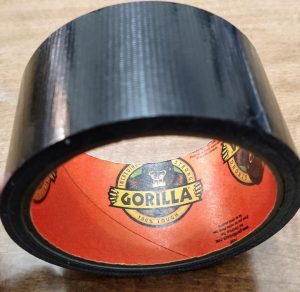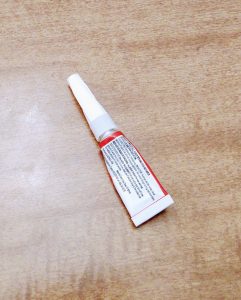A lot of time and energy is spent on acquiring gear that is either stowed away for a rainy day or used frequently.
We talk about the best gear to purchase and all the different ways that it can be used.

Our gear is incredibly important to us and we rely on it greatly. But what do we do when a piece of gear or clothing becomes damaged in some way when we are away from home?
This is an important question that does not receive much attention but is certainly worth addressing because sometimes we depend on that gear with our lives.
And this is why it is so important to carry some type of gear repair kit.
There are premade gear repair kits available that can be bought but I prefer making one myself.
Creating a repair kit is not only easy but it can be cheaper and can be customized to your specific abilities and gear.
SKIP AHEAD
12 Gear Repair Items to Include
Here are the items I like to include in a gear repair kit that is easy to carry in a pack or in a vehicle.
Tools
The kind of tools that you put into a repair kit is going to depend on the gear that you carry.
For instance, there is no need to carry a screwdriver if none of your gear has this type of hardware.
However, here are a few common tools that I find useful that many people probably already carry in an outdoor pack.
- Knife
- Scissors
- Lighter
- Multitool like a Leatherman or Swiss Army Knife
Duct Tape
Duct tape is the number one gear repair item I have used in my life. And most experienced outdoorsmen I have spoken to have used it extensively as well.
This tape is both affordable and incredibly effective. I have used this tape to hold boots together while going through mud and water, to patching holes in a pack, or even creating a useful tool such as straps.
If there is room available in a pack, it is never a bad idea to carry an entire roll of duct tape because it can be used in so many ways.
But I understand that an entire roll of this tape does not pack well and takes up space.
A better option is to find a flat, rectangular piece of metal that the tape can be wrapped around. This allows you to decide how much tape to carry and fits much better in a pack.
There are several different kinds and brands of tape to choose from and which one to carry is a personal choice. While it is a little more expensive, I like Gorilla Tape because it is incredibly strong.
Choose the type you prefer but I would suggest staying away from cheap knock-off brands.
For just a few bucks, a lot of this universally accepted repair material can be purchased.
Gorilla Glue
This is a type of crazy or instant glue that adheres most materials together very quickly.
Glue like this works great for repairs in areas where using tape is difficult to apply. A small nozzle on the bottle allows the glue to be applied precisely without waste.
This glue holds so well that often the repair can be a permanent fix. So be careful and thoughtful about its application because once it has dried it can be difficult to remove.
Sewing Thread
Some of the most important gear that we carry are the clothes on our back and a pack to carry our supplies. These two items are going to be made from some type of fabric.
When those fabrics rip or tear, we run into a very big problem. Unless of course, they can be repaired and the best way to do that is by sewing.
Needles
If you plan on fixing fabrics by sewing then you will need a set of needles.
Note that I did not say one needle but a set of them. This is because small needles will not work on thick or tough material and large needles will not work on thinner material.
It is best to have a set of needles that range from small to larger upholstery style needs to tackle any repair you may run into.
Paracord Yarns
Other than sewing thread, I also like to use paracord yarns. These yarns are extraordinarily strong and work great for repairs requiring a higher level of strength.
For example, I have used these yarns to repair a pack handle as well as a pair of my shoes. Those two repairs have held up for over a year.
I typically use a whole yarn, but a whole piece can be broken down into thinner components for more delicate work.
If you carry paracord then the yarns can be harvested from the core as you need them. But another option is to keep yarn scraps and reuse them for this purpose.
The way I have done this is by wrapping the yarns around an old sewing thread roll. This has worked very well for keeping them organized and ready to go when I need them.
Paracord Lacing Needle
This may not be for everyone but if you use paracord a lot then I highly suggest carrying a paracord lacing needle.
This is a large, hollow needle with threads on one end. A whole piece of paracord can be secured into the threaded end and then it can be used much like a normal needle and sewing thread.
This tool makes larger repairs with paracord much, much easier.
Glue Stick
Carrying glue sticks is usually not considered because most people think it will not work without the glue gun. While the glue gun does make using the glue stick easier, all that is really required, is a heat source.
As long as a fire can be started or you have a lighter, the tip of the stick can be melted and then applied to the repair area.
This type of glue does form a strong bond, but it is nowhere near as strong as instant glue or gorilla glue. But it works well for temporary repairs as the glue is somewhat easy to remove.
Miscellaneous Hardware
I also like to pack an assortment of various hardware that can be used for repairing gear, clothing, or for any random task I may come across.
Here is a small list of miscellaneous hardware I have found useful to carry.
- Buttons. Losing a button on an article of clothing does not happen a lot but when it does it can be extremely frustrating. Therefore, it is worthwhile to carry at a minimum a few different sizes of buttons.
- Shackles. These do a good job of holding two items together, like straps or cordage.
- Plastic Clasps and Buckles. If a piece of gear has a strap it is likely it also has a clasp or buckle of some kind. Usually, this hardware is made from plastic which can break or become worn out. Having a few spares can be helpful.
- Keyrings. This may seem like an odd item to have but you would be surprised at the different ways it can be used. With it, I have made impromptu zipper pulls as well as adjustable loops in cordage.
Carrying it All
Once you have decided on the items you want in your kit, you are going to want to put them into some kind of container. This will help protect them as well as help keep the items organized.
A soft container such as a tool roll works well from an organizational standpoint and I have used these before. But they do not offer the best physical protection or protection from water.
A hard sealed container is a better choice, and the options are infinite depending on what items you choose to put into it.
If you want to go super cheap, I suggest reusing a container that you can find laying around your home.
For example, here I reused a hard plastic bottle with a screw-on lid that use to have peanuts in it. After a quick rinse with warm soapy water, I put my repair items inside. They are now protected and will stay dry.
Wrap Up
The items listed above are what I have found work well for me during my time in the outdoors.
Some of the items listed in the kit may work for you and some may not. This is because everyone carries different gear which may require different types of materials for repairs.
By taking just a little bit of time and thinking through your gear you can create an affordable kit that works best for you.
I hope you enjoyed the article, thanks for reading, and stay prepared!
What items do you like to carry in a gear repair kit? Sound off in the comment section below and let us know!












